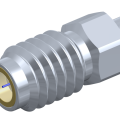Overview of aldolization modifications on biochip surfaces
Biochip surface aldolization modification is a commonly used surface functionalization method for introducing aldehyde (-CHO) functional groups on the surface of biochips.
This modification allows for the immobilization and detection of specific biomolecules through a series of chemical reactions that form reactive groups on the surface of the biochip that can chemically react with other molecules.
Below is an overview of the steps involved in aldolization modification of a biochip surface:
1. Surface activation: The surface of the biochip usually needs to be activated to increase the reactivity and hydrophilicity of the surface. Commonly used activation methods include plasma treatment, UV irradiation, or the use of chemically activated agents.
2. Surface Silanization: Next, the surface of the biochip is usually silanized to introduce silane (-SiR3) functional groups. Silanizers are usually compounds containing silyl groups, such as trimethylchlorosilane. This step increases the hydrophilicity of the surface and provides a suitable basis for the next step of aldolization modification.
3. Surface aldolization: The key step in aldolization modification is the introduction of aldehyde functional groups. A common method is to react the silanized biochip surface with compounds containing aldehyde groups. For example, compounds such as 4-hydroxybutyraldehyde or glutaraldehyde can be used. These aldolization reagents react with the hydroxyl groups on the silanized surface to form stable aldehyde groups.
4. Elution and closure: After completing the aldolization modification, it is necessary to elute the unreacted compounds to avoid interference with subsequent experiments. Commonly used elution methods include solvent elution, centrifugal elution or surfactant elution. Finally, the remaining surface aldehyde groups can be closed by reacting with nucleophilic reagents (e.g., amine-based compounds) to prevent nonspecific adsorption.
Immobilization and detection of specific molecules on biochips can be achieved by aldolization modification on the biochip surface. Aldehyde functional groups can react with functional groups such as amine groups and sulfhydryl groups to form stable covalent bonds, thus realizing targeted immobilization of biomolecules.
Surface aldolization modification
1 Molecular immobilization: Aldehyde functional groups can react with functional groups such as amine groups and sulfhydryl groups to form stable covalent bonds, thus realizing the immobilization of biomolecules on the chip surface. This immobilization can be used in the preparation of sensors, biochip arrays, and other applications so that specific biomolecules (e.g., antibodies, oligonucleotides, proteins, etc.) can be securely attached to the chip surface and provide reliable signal detection.
2 Biomolecule detection: The aldolization-modified biochip surface has specific chemical reactivity and can react selectively with specific biomolecules. By contacting the biomolecules to be detected with the modified chip surface, the capture and detection of biomolecules can be realized. This method is widely used in the fields of biosensors, biochips and molecular diagnostics.
3 Surface modification: Aldehyde-based modification can also change the chemical and physical properties of the surface of a biochip. The modified surfaces can have different hydrophilicity, charge characteristics and biocompatibility to meet the needs of specific applications. For example, the introduction of aldehyde groups on a biochip can increase its ability to interact with other molecules or materials, enabling more sophisticated analytical and detection functions.
Overall, aldolization modification on the surface of biochips provides an effective method for the immobilization and detection of biomolecules. Specific immobilization of biomolecules can be achieved through the introduction of aldehyde functional groups, and highly selective detection of target molecules can be achieved through chemical reactions with specific reactants. This modification method has a wide range of applications in the fields of biosensing, biochips and molecular diagnostics.
Dxfluidics Processing Capabilities

DXFLUIDICS
An innovative company focusing on microfluidic chips and biochips, etc., is able to provide customized surface modification/modification services for microfluidic chips and biochips with the help of the company's new material surface coating processing technology. Our coating processing technology can enhance the surface properties of chips, improve their durability, corrosion resistance and biocompatibility, and realize specific functions, such as enhanced signal transmission, antimicrobial and cell adhesion control. By partnering with us, customers can gain access to advanced coating solutions in the field of microfluidic chips and biochips, opening up a wider range of possibilities for their research and applications.
For more details, please consult the customer service: Zhou Manager 17751163890 (with WeChat)
© 2025. All Rights Reserved. 苏ICP备2022036544号-1















